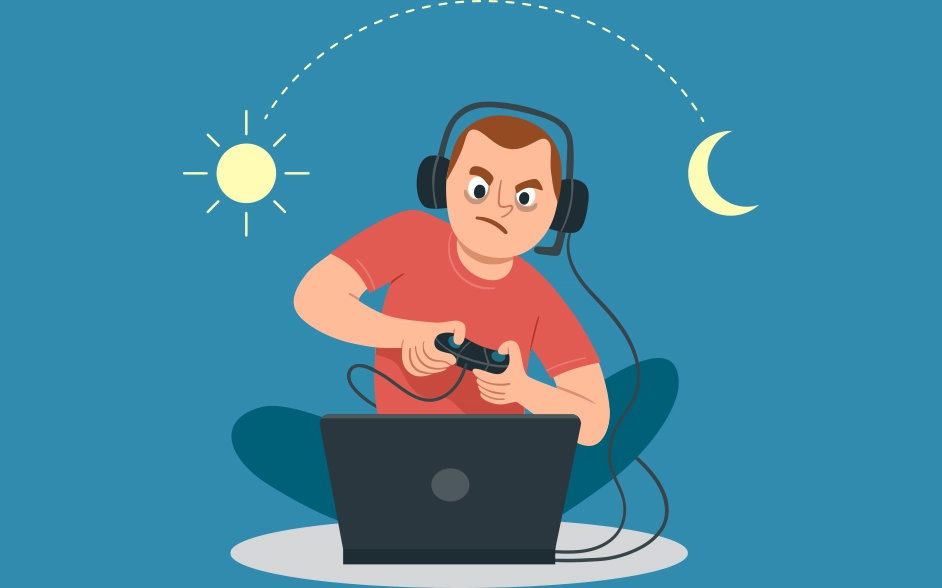- Mumbai, New Delhi, Bangalore
- (+91) 81518 30000
- WhatsApp Now
- contact@vedawellnessworld.com
There’s no single magic number for everyone. But when daily play starts crowding out sleep, school/work, exercise, meals, or relationships and you can’t cut back even when you try then you know that’s “too much.” That pattern is what the World Health Organization classifies as gaming disorder: impaired control, prioritizing gaming over other life areas, and continuing despite harm, typically persisting for 12 months.
Below is a simple, research-based guide with clear thresholds you can use at home, plus the latest stats on prevalence, health effects, and the games industry’s size.
What this means for hours: A big number alone doesn’t equal addiction but higher hours do raise risk. A 2024 analysis found risk accelerates around 35–40 hours/week (5–6 hours/day) when judged against APA/WHO criteria. That’s not a rule, but it’s a useful “yellow-to-red zone” marker which one must be made aware of.
These are guidelines, not prescriptions. Adjust for age, school/workload, sleep, and health.
A quick home test: For two weeks, schedule sleep/exercise/meals/study first. Put gaming in the leftover time. If you can’t hold that boundary or you feel edgy/low when you stop, that’s a warning sign.
Sleep: Excess gaming is linked to poorer sleep quality and delayed bedtimes, especially with late-night sessions, competitive play, or bright screens. Sleep loss then worsens mood, attention, and decision-making which is a vicious loop for teens and adults.
Musculoskeletal Strain: Longer sessions correlate with neck, back, shoulder, wrist/hand pain; poor ergonomics and marathon play are common culprits. Regular breaks, posture cues, and controller/desk adjustments help.
Weight & Metabolic Health: Higher gaming time is associated (on average) with higher BMI and lower self-rated general health which is likely due to less movement and more snacking. Active games and scheduled workouts can offset this, but they don’t erase overnight binges.
Mental Health: Context matters. For some, gaming offers stress relief, social connection, and cognitive challenge; for others, it becomes an avoidance strategy that worsens anxiety, low mood, or ADHD-related difficulties. Net effects depend on what is played, when, with whom, and for how long.
So, what is “too much” in plain language?
Use this three-part rule:
1. Hours: Be cautious beyond 3 hours/day on a regular basis, and treat 5–6+ hours/day as a high-risk zone unless you’re meeting sleep (7–9h), movement, meals, and school/work goals consistently.
2. Harm: If gaming regularly displaces essentials (sleep, nutrition, study/work, hygiene), or triggers conflict, secrecy, or financial strain, it’s too much, regardless of the clock.
3. Control: If you can’t cut back or stop despite plans and reminders, consider a brief digital detox and, if needed, professional help.
1. Pick a bedtime and protect 8–9 hours for teens, 7–9 for adults.
2. Front-load obligations (school/work, chores, exercise). Gaming goes after the essentials.
3. Cap sessions at 45–60 minutes, with a 5–10-minute break to stretch eyes, hands, shoulders.
4. No late-night competitive queues (adrenaline wrecks sleep).
5. Social > solitary when possible; co-op with friends can be healthier than endless solo grinding.
6. Turn off autoplay for videos/streams; set hard stop alarms on phone/console.
7. Track mood, sleep, and urges. If cravings spike when you cut back or you feel low/irritable off-game, note it. That’s useful data for a clinician.
Consider a professional consult if:
Treatment typically blends psychoeducation, cognitive-behavioral strategies, family work, and sleep/exercise resets. In the UK, for example, a dedicated National Centre for Gaming Disorders provides structured care pathways, evidence that help is increasingly accessible. (Centers like ours in India, such as Veda Rehabilitation and Wellness also integrate screen-use interventions within broader mental-health programs, discreetly and with a focus on real-life functioning.)
Some studies show cognitive benefits (attention/working memory) in frequent young gamers, but this doesn’t negate sleep loss, sedentary time, or compulsion risk. Balance beats extremes.
Big 6–10-hour marathons can bring eye strain, headaches, wrist pain, and sleep disruption. Spread play more evenly, and break every hour.
Social play can be protective, but late-night competitive sessions still hammer sleep and mood. Keep curfews and wind-down routines.
Bottom line
You don’t have to “quit gaming” to protect mental and physical health. You just need clear boundaries, good sleep, regular movement, and honest check-ins. If that sounds hard, that’s exactly what modern mental-health teams (yes, including discrete private programs in India) help families build calmly, practically, and without judgment.
